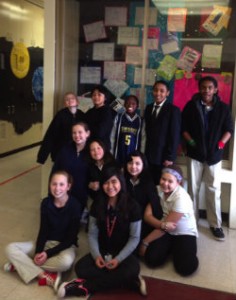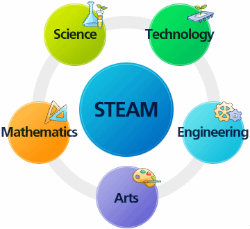The Arts Effect: How STEM Becomes STEAM
A MiddleWeb Blog

I’d like to introduce you to a new colleague, Ruth Catchen, a STEAM consultant in Colorado Springs, Colorado. Ruth’s journey through life has led her from opera singer to music educator to STEAM advocate, always working with youth in some capacity. We have talked at length about STEM and STEAM and we’re on the same page as to what quality STEAM curriculum could look like.
I’ve invited Ruth to write a blog post highlighting her candid thoughts as an arts educator about how STEM becomes STEAM.
~ • ~

Argument and discussion abound over what STEAM might be. Some of the conversation is civil, while other comments sound more like educators who are staking out their turf, worried that their favorite discipline will get short shrift. Here’s what I think:
STEAM, or as I sometimes spell it, STE[+a]M, seems to me the most logical way to learn. The goal is to use cross-curricular experiences and a variety of deep content, combined with discovery through real world activities, to maximize learning. It allows students to learn from their strengths and improve their weaker skills.
![STE[a]M-table 270 | MiddleWeb STE[a]M-table 270](https://www.middleweb.com/wp-content/uploads/2014/06/STEaM-table-270.jpg)
It is a way of learning that maximizes the concept of divergent thinking. We need the arts and our ability to communicate to do anything. As well we must view things from the eye of a critical thinker, which is one who constantly wants to solve problems or make things work more efficiently.
STEM is hard to define, but those of us who work with students engaged in STEAM lessons can see that the arts help make STEM personal – just the way adolescents like their learning. STEAM accentuates experiential, hands-on education. It encourages connection and collaboration. As students seek to solve diverse problems, their creative juices are set into motion by an infusion of arts thinking. Students feel more in charge of what and how they learn.
I hope math and science teachers won’t view the STEAM acronym as a limitation. From my perspective it’s an opportunity to open the learning box, pull out the science and math and art, and light up the world. It’s the perfect way to address most or all of the 21st century skills we hear about so much.
The how-to challenge
The how-to piece of STEAM becomes the challenge. Students must learn the separate disciplines and how they all work together. STEAM must evolve with STEM as its core. This learning includes the ability to be problem solvers who gather information, test that information, use it, draw conclusions and then apply their knowledge to something new. In doing those activities, students can creatively use science, mathematics and technology and apply it to the engineering design process.

A Group of Ruth’s STEAM Students
In learning how to do and how to use all of those things, students will become innovative and self-reliant. They will understand how things follow logically and how to test, invent and re-design. Resiliency and resourcefulness are valuable by-products of STEAM and are needed for life in the 21st century. Just like in science and engineering, individuals working in the arts have to try and fail and try again. Connecting students with tangible arts experiences as they pursue engineering design goals broadens and enlightens their thinking and their ability to comprehend advanced content.
Let’s clear up a misconception I often come across. STEAM is not, for example, having students use interpretive dance to demonstrate how molecules move. Instead it allows different neural pathways (we might call them Head & Heart) to work in harmony. Although humans cannot use both neural pathways at once, they can process and use critical thinking skills to combine the experiences from both, creating a better outcome.
This process is what STEAM should exemplify. If students use scarves to simulate the movement of plants in space or microgravity, it allows them the freedom of self-expression that lifts their ability to imagine and create to a new level. In addition, students find this activity fun. It is not meant to replicate a scientific given; it is to allow for creative thought that will apply to new things.
As a result, students who learn through a pedagogy such as STEAM become more inventive and resourceful in finding answers to important questions. STEAM allows for the arts to be a learning tool that benefits the learning style of diverse students. It takes abstract concepts and makes them experiential, moving beyond a “follow the steps” protocol or the predetermined outcomes offered students in so many cookie-cutter science labs. Instead students find solutions that they can’t easily “Google,” and design thinking becomes a regular part of the STEM/STEAM experience.
People will say, “We need to stimulate creativity and innovation.” So therefore, STEAM?
“Yes,” I say, “but are we sure we know what we are seeking?”
Creativity precedes innovation

Let me tell you what I think creativity is not. Many of us interpret those who are creative as “artistic” or unconventional. As a result, we may think those who are creative have avant-garde hairstyles, edgy clothing or an excessive number of tattoos. I understand how one may view this behavior as creative, but to me, it’s not. It is self-expression.
Creativity is the ability to take something that you know or have and make it something else. It is the ability to see beyond the lines or the rules. It is opening the space for stimulating conversation and ideas, some of which may be nonsense, but being compelled to follow them to their logical end. Creativity takes experiences and marries them to apply to something new. It is seeing something that for now is not there, and then making it happen.
And what of innovation, you might ask? Innovation follows when creativity is applied and something emerges that is new or made better.
It is arguable that STEM is STEAM and STEAM is STEM. Creativity is often an aspect of great engineering, for example. The point is not to be locked in the box. The point is to include pieces of integration, innovation, and imagination that inspire.
Students must learn to observe, create, evaluate and correct. Their exposure must include design, experimentation, and substantive experience. And yes, they need to fail, analyze, and try again. Students and parents must learn that all education is a process of discovery and advancement through struggle.
There are many ways to implement STEAM. Give me a standard and I’ll give you an idea.
Read about my journey of STE[a]M discovery in The STE[a]M Journal:
- REFLECTIONS- HOW STEM BECOMES STE[A]M
- Musings From a Year of STE[a]M…How It Looks Walking Down the Path
Ruth Catchen received her Bachelor of Music degree from American University and her Master of Music degree from The Catholic University of America in Vocal Performance. She has performed with many distinguished opera companies, conductors and orchestras in the United States. Later in her career, she turned her direction to music education and founded a youth chorale with the Naples (FL) Philharmonic Orchestra. She received a second master’s degree in 2007 from the University of Colorado in Curriculum and Instruction/Leadership. Since then, she has worked in developing arts integrated curriculum programs for various schools and school districts. She serves as co-chair for the Girls’ STEM Experience in Southern Colorado and also served on the advisory committee to create STEM standards for the Colorado Department of Education. She blogs at http://ruthcatchen.wordpress.com/.
Photo #1: STEAMConnect / ThoughtSTEM booth at the Balboa Park STEAM Family Day, March 2014
Photo #2: Students at Jack Swigert Aerospace Academy in Colorado Springs, CO display their projects.


































Am I missing something here? I see no mention of foreign language proficiency. How can we talk about a global economy, and interconnectedness, and shrinking world, and preparing students for the 21st century, and ignore the study – no, the proficiency – of being able to communicate in a second language? I’m all for art and music being part of STEM, but i hear very little about the importance of speaking and understanding another language and culture. Yet, the rest of the world is sending out highly qualified STEM candidates who also are multilingual and multicultural. How can American students compete with that?
Thank you Linda for your comment.
Studying a foreign language may or may not be included in a college preparation program. Almost all colleges still require it, but many states have taken this requirement away from getting a high school diploma. Here in Colorado you do not need a foreign language to graduate from High School. This is in many ways poor planning, as most colleges require it as a prerequisite.
There is no doubt that a global economy exists and students need a new perspective to prepare for the future. The arts in STE[a]M are not an additional academic subject to learn, but rather a learning tool to deepen learning experience and understanding.
Reading and writing are required for anything one pursues in life and needed to communicate, however, not included in the STEM/STEAM acronym. How could you do science or math without reading? The inclusion of essential elements for college and career readiness and preparation for a “global economy” is an aim of a STEAM pedagogy. Just because all of the elements are not listed in the acronym, does not mean they are not needed. The goal of STEM/STEAM is to increase participation and success in these subjects and, as a result, preparation for college and career
Ruth